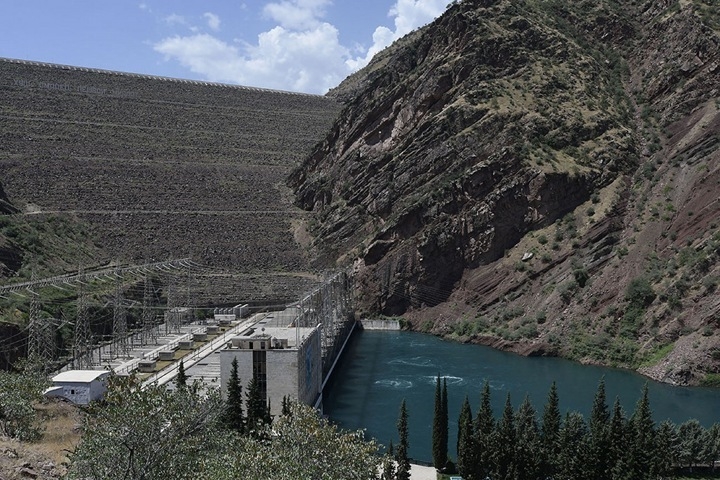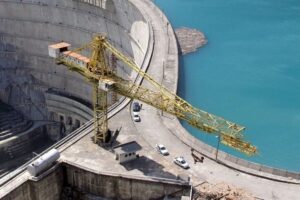The Tajik authorities promise to achieve complete elimination of seasonal electricity shortages and «absolute energy independence in 2.5 years. Is this achievable?

President of Tajikistan Emomali Rahmon, in his latest message to the country’s parliament, said that starting in May 2027, the electricity shortage in the country will be completely eliminated and the republic «will achieve absolute energy independence». He explained his statement by increasing electricity production at the Rogun hydroelectric power station and other operating stations, as well as the construction of new capacities.
The President noted that work is currently ongoing on the reconstruction and modernization of the «Nurek» and «Kairakkum» hydroelectric power stations and the construction of the «Sebzor» hydroelectric power station for a total amount of 7.6 billion somoni. Due to this, he said, the country’s existing energy capacity will increase by 180 megawatts in 2025 alone.
«Along with this, – he said, – in 2025, construction of a solar power plant with a capacity of 200 megawatts» will begin in the Sughd region.
In addition, Emomali Rahmon emphasized that «construction of the Rogun hydroelectric power station» continues at an accelerated pace, and almost 50% of the construction work on this station has been completed.
The President noted that to complete the construction of the hydroelectric power station, preferential funds from international financial organizations and development partners in the amount of $3 billion are being attracted, including grants of – $1.2 billion.
According to him, agreements have already been signed with six donors totaling about $1 billion, including grants worth $350 million. «In 2025, investment will begin on their part», – he said.
The Ministry of Energy confirms
A few days later, the country’s Ministry of Energy and Water Resources justified the president’s statement in a publication on the website «Howar».
It states, in particular, that along with the reconstruction, modernization of existing and construction of new stations, the efficiency of the Vakhsh cascade of hydroelectric power stations will improve due to an increase in the water level in the Rogun reservoir.
The ministry notes an increase in electricity generation due to renewable sources. It is expected that by 2030 the capacity of such stations will grow to 1,500 MW, some of which will be put into operation by the end of 2027.
According to forecasts of the Ministry of Energy, at the moment the existing production capacity can generate 22 billion kilowatt-hours of electricity per year, and in a couple of years production will increase by 8 billion kWh – to 30 billion kWh. In addition, the Ministry of Energy includes reducing electricity losses as important measures to improve the country’s energy supply.
According to the Ministry of Energy, for the nine months of 2024, total losses amounted to 3.3 billion kWh with a total output of 17.2 billion kWh. That is, we lost 19.4%, or almost a fifth of the energy generated in the country.
«Reducing the volume of electricity losses is considered one of the important goals, and measures are being taken in this direction through the timely implementation of projects», – the ministry emphasizes.
According to the Ministry of Energy, projects to reduce losses are operating in the cities of Dushanbe, Penjikent, Istaravshan, Isfara, Kanibadam, Buston, Kulyab, Bokhtar, as well as in the Dangara region. The department also expects that by 2027 all consumers in the country will be provided with smart meters.
«The implementation of projects in this direction will make it possible to turn losses into effective electricity», – concludes the Ministry of Energy.
It all depends on implementation
Independent expert on energy issues Kamoliddin Sirojiddinov, in an interview with «Asia-Plus», said that Tajikistan has all the necessary conditions, resources and capabilities to fully meet the country’s electricity needs through domestic generation in the near future. However, he noted, it all depends on how much these opportunities can be realized.
Sirodzhiddinov talks not only about increasing the capacity of the Rogun hydroelectric power station, but also about the implementation of other projects. These include, among other things, projects for the reconstruction and modernization of the Nurek and Kairakkum hydroelectric power stations, as well as the commissioning of new capacities.
Regarding the Rogun hydroelectric power station, the expert noted that the installation of the next, third unit, according to the latest data, will take place only in 2028. However, he noted, by increasing the water level in the tank in the next two years, the capacity of each of the two operating units of the station could increase to 140-150 MW. He emphasized that they are currently operating at a minimum capacity (90 MW each). In other words, the total capacity of these units may increase by 100-120 MW.
It should be noted that the height of the Rogun Dam is planned to be raised in 2027 to 1185 m above sea level from the current 1110 m (in 2024), which will significantly increase the capacity of existing units.
Sirodzhiddinov, citing official data, said that the electricity shortage in the autumn-winter period is estimated at approximately 2 billion kilowatt-hours, which can be covered by the planned increase in capacity. Moreover, he continued, issues related to the financing of the above projects for the coming years have already been resolved.
Meanwhile, the expert emphasized that there are important issues that the authorities do not publicly talk about. This is, first of all, the modernization of the electric power infrastructure in rural areas, that is, its preparation for additional loads in the autumn-winter period, which costs considerable financial investments.
Sirodzhiddinov added that dilapidated infrastructure, part of which is a legacy of the Soviet Union, for example, transformers and lines may not withstand additional load in the autumn-winter period.
Not everything is so rosy
Other experts view statements about achieving energy independence in the near future with a lot of skepticism.
They consider hopes for a significant improvement in the country’s energy supply in the coming years by increasing Rogun’s capacity to be premature.
Funds allocated by external donors are allocated for the production of the next two units, the installation of which will begin only in 2028. At the same time, funds received on the basis of concluded agreements (about $1 billion) will be received in stages, in tranches. For example, in 2025 it is planned to allocate only about $220 million.
Further financing of the project through preferential lending to development partners also raises questions. The fact is that the attracted loans increase the ratio of external debt to GDP, and international donors, after exceeding this figure of 40%, refuse further lending to countries with the level of development of Tajikistan.
There are also doubts about a significant improvement in the republic’s energy supply due to the installation of solar power plants in the next two years, since projects in this direction are still at the stage of agreement with donors.
The argument about the contribution of the small hydroelectric power station «Sebzor», which is being built in the Roshtkalinsky district, is considered frivolous, since the installed capacity of this station is only 11 MW.
With such capacity, it is possible to cover the lack of energy in remote areas of the region itself, as well as electrify, perhaps, a couple of adjacent villages in Afghanistan, which, in principle, the European donors of the project hope for.
There are no questions regarding the reconstruction and modernization of the Nurek hydroelectric power station and the Karakum hydroelectric power station, but these are far from the capacities that can greatly change the situation with energy supply in the country (Nurek’s capacity increases by 40 MW, and Kairakkum’s – by 24 MW).
Moreover, the number of electricity consumers is growing at a high rate every year. According to official figures, in 2024 alone, 740 new production workshops and enterprises were created, which are naturally additional consumers.
The number of household consumers is also growing – the country’s population growth over the past decades is 2.2%, and this, by the way, is the highest figure in the post-Soviet space and one of the highest in the world.
Payrav Chorshanbev (Asia-Plus)




